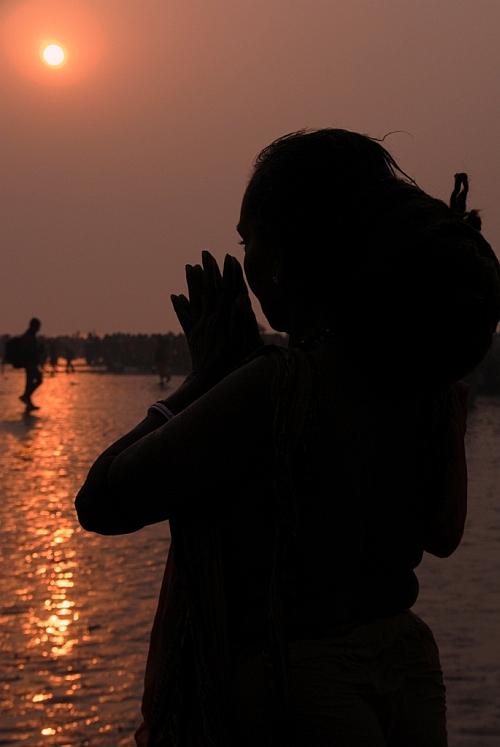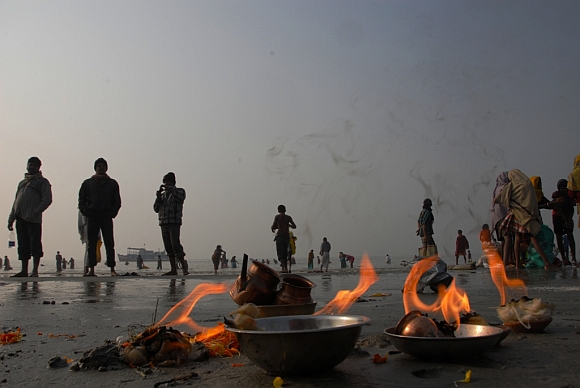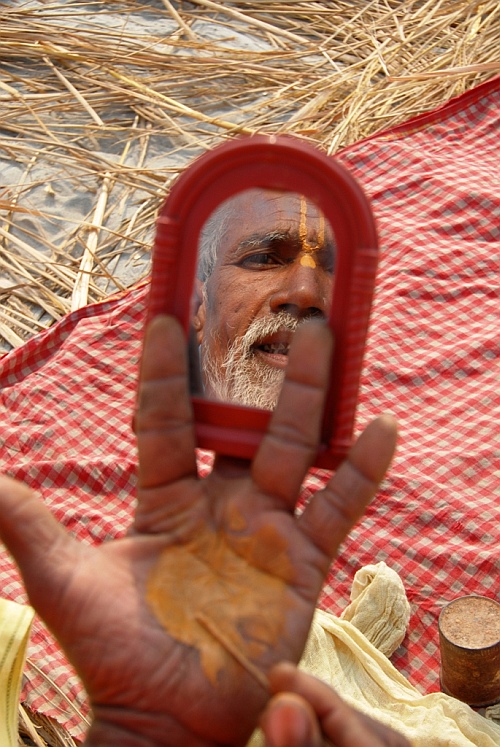Photographs: Dipak Chakraborty
The Gangasagar pilgrimage and fair is the second largest congregation of mankind after the holy Kumbha Mela at Prayag.
The Gangasagar fair and pilgrimage is held annually on the Sagar Island's southern tip in the Ganges delta atop the Bay of Bengal, which makes Gangasagar all the more distinctive.
Click NEXT to see MORE PICTURES...
IN PICS: GANGASAGAR MELA, the Kumbh of the east
Photographs: Dipak Chakraborty
Thousands of pilgrims from different parts of the country gather at Gangasagar, the point where the holy river Ganges meets the sea, to take a dip and wash away all the earthly sins. Makar Sankranti falls on the day of the year when the sun-considered the king of all grahas (planets)-is in the rashi (zodiac sign).
Click NEXT to see MORE PICTURES
IN PICS: GANGASAGAR MELA, the Kumbh of the east
Photographs: Dipak Chakraborty
The Kapila muni temple at this site is a center of worship. The origins of this temple are obscured in antiquity -- the current structure being a recent one, housing a stone block considered to be a representation of Kapila Mu#8715 there are are also images of Bhagiratha, Rama and Sita.
Click NEXT to see MORE PICTURES...
IN PICS: GANGASAGAR MELA, the Kumbh of the east
Photographs: Dipak Chakraborty
A dip in the ocean, where the Ganga drains into the sea is considered to be of great religious significance particularly on the Makara Sankranti day when the sun makes a transition to Capricorn from Saggitarius and this town becomes home to vast fairs, drawing visitors and recluses (sanyasis) from all over the state.
Click NEXT to see MORE PICTURES...
IN PICS: GANGASAGAR MELA, the Kumbh of the east
Photographs: Dipak Chakraborty
You can go to all the holy places, but a pilgrimage to Ganga Sagar equals them all. A dip means redemption for all wrong done.
This place is Sagar Island, on the confluence of the Ganga with the Bay of Bengal. The day "Makar Sankranti" or the last day of the month of Paus (December).
Click NEXT to see MORE PICTURES...
IN PICS: GANGASAGAR MELA, the Kumbh of the east
Photographs: Dipak Chakraborty
Legend has it that, before joining the sea, the Ganga watered the mortal remains of King Sagar's 60,000 sons liberating their souls once and forever.
It was standing on the Sagar Island that the mythical Kapil Muni condoned the sins of the sons of King Sagar who had dared to stop the horse blessed at Lord Indra's Aswamedha Yagna and tied it to a post near his temple.
Click NEXT to see MORE PICTURES...
IN PICS: GANGASAGAR MELA, the Kumbh of the east
Photographs: Dipak Chakraborty
It is this legend that attracts people to this little island in a remote southern corner of West Bengal.
The greatness of the mela can be assessed from the fact that over a million pilgrims come from far-flung corners of India and beyond, speaking different languages and belonging to diverse castes and creeds, for a sacred dip at this holy confluence.
Click NEXT to see MORE PICTURES...
IN PICS: GANGASAGAR MELA, the Kumbh of the east
Photographs: Dipak Chakraborty
For this, no invitation is given. No propaganda is carried out and overall no authority exists for carrying out the mela.
Click NEXT to see MORE PICTURES...
IN PICS: GANGASAGAR MELA, the Kumbh of the east
Photographs: Dipak Chakraborty
In 2007, about 300,000 pilgrims took the holy dip where the Hooghly meets the Bay of Bengal on the occasion of Makar Sankranti. The figure was lower by around 200,000 because of Kumbh Mela.
For the rest of the year about 500,000 people come to the island.
Click NEXT to see MORE PICTURES...










article